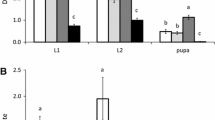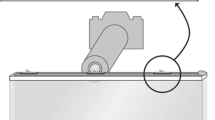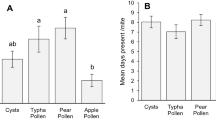Abstract
The eriophyoid mite Aceria guerreronis Keifer (Eriophyidae), commonly called the coconut mite, is a key pest of coconut fruits. Surveys conducted on coconut palms in Brazil revealed the predatory mites Neoseiulus paspalivorus DeLeon (Phytoseiidae) and Proctolaelaps bickleyi Bram (Ascidae) as the most commonly associated natural enemies of A. guerreronis on coconut fruits. However, virtually nothing is known about the life history of these two predators. We conducted laboratory experiments at 25 ± 0.1°C, 70–90% RH and 12:12 h L:D photoperiod to determine the life history characteristics of the two predatory mites when feeding on A. guerreronis and other potential food sources present on coconut fruits such as Steneotarsonemus furcatus DeLeon (Tarsonemidae), coconut pollen and the fungus Rhizopus cf. stolonifer Lind (Mucoraceae). In addition, the two-spotted spider mite Tetranychus urticae Koch (Tetranychidae) was tested for its suitability as prey. Both predators, N. paspalivorus and P. bickleyi, thrived on A. guerreronis as primary food source resulting in shorter developmental time (5.6 and 4.4 days, respectively), higher oviposition rate (1.7 and 7.0 eggs/female/day, respectively) and higher intrinsic rate of increase (0.232 and 0.489 per female/day, respectively) than on any other diet but were unable to develop or lay eggs when fed T. urticae. Coconut pollen and S. furcatus were adequate alternative food sources for N. paspalivorus and Rhizopus for P. bickleyi. We discuss the relevance of our findings for natural and biological control of the coconut mite A. guerreronis.


Similar content being viewed by others
References
Abou-Awad BA, Korayem AM, Hassan MF, Abou-Elela MA (2001) Life history of the predatory mite Lasioseius athiasae (Acari: Ascidae) on various kinds of food substances: a polypeptide analysis of prey consideration. J Appl Entomol 125:125–130
Bellows Jr TS, van Driesche RG, Elkinton JS (1992) Life-table construction and analysis in the evaluation of natural enemies. Annu Rev Entomol 37:587–614
Birch LC (1948) The intrinsic rate of natural increase of an insect population. J Anim Ecol 17:15–26
Dicke M, Sabelis MW, De Jong M, Alers MPT (1990) Do phytoseiid mites select the best prey species in terms of reproductive success? Exp Appl Acarol 8:302–309
Engel R, Ohnesorge B (1994) Die Rolle von Ersatznahrung und Mikroklima im System Typhlodromus pyri Scheuten (Acari: Phytoseiidae)—Panonychus ulmi Koch (Acari: Tetranychidae) auf Weinreben. I. Untersuchungen im Labor. J Appl Entomol 118:129–150
FAO (2005) FAO Agricultural Statistics. Food and Agriculture Organization of the United Nations http://www.fao.org
Fernando LCP, Wickramananda IR, Aratchige NS (2002) Status of coconut mite, Aceria guerreronis in Sri Lanka. In: Fernando LCP, de Moraes GJ, Wickramananda IR (eds) Proceedings of the International Workshop on Coconut Mite (Aceria guerreronis). Coconut Research Institute, Lunuvila. January 6–8, 2000 Coconut Research Institute, Sri Lanka, pp 1–8
Gerson U, Smiley RL, Ochoa R (eds) (2003) Mites (Acari) for pest control. Blackwell Publishing, Oxford, United Kingdom
Helle W, Sabelis MW (eds) (1985) Spider mites. Their biology, natural enemies and control, vol 1B. Elsevier, Amsterdam
Hulting FL, Orr DB, Obrycki JJ, (1990) A computer program for calculation and statistical comparison of intrinsic rates of increase and associated life table parameters. Fla Entomol 73(4):601–612
James DG (1989) Influence of diet on development, survival and oviposition in an Australian phytoseiid, Amblyseius victoriensis (Acari: Phytoseiidae). Exp Appl Acarol 6:1–10
Kamburov SS (1971) Feeding, development and reproduction of Amblyseius largoensis on various food substances. J Econ Entomol 64:641–648
Lawson-Balagbo LM, Gondim MGC Jr, de Moraes GJ, Hanna R, Schausberger P (2007a) Exploration of the acarine fauna on coconut palm in Brazil with emphasis on Aceria guerreronis (Acari: Eriophyidae) and its natural enemies. Bull Entomol Res (in press)
Lawson-Balagbo LM, Gondim MGC Jr, de Moraes GJ, Hanna R, Schausberger P (2007b) Refuge use by the coconut mite Aceria guerreronis: fine scale distribution and association with other mites under the perianth. Biol Control (in press). doi:10.1016/j.biocontrol.2007.05.010
Mariau D (1977) Aceria (Eriophyes) guerreronis: un important ravageur des cocoteraies africaines et américaines. Oléagineux 32(3):101–111
McMurtry JA (1982) The use of phytoseiids for biological control: progress and future prospects. In: Hoy MA (ed) Recent advances in knowledge of phytoseiidae. Univ Calif Press, pp 23–84
McMurtry JA (1983) Phytoseiid predators in orchard systems: a classical biological conrol success story. In: Hoy MA, Cunningham GL, Knutson L (eds) Biological control of pests by mites. Div. Agriculture and Natural Ressources, Berkeley, Univ Calif Press, pp 57–60
McMurtry JA, Croft BA (1997) Life-styles of phytoseiid mites and their roles in biological control. Annu Rev Entomol 42:291–321
McMurtry JA, Huffaker CB, Van de Vrie M (1970) Ecology of tetranychid mites and their natural enemies: a review. I. Tetranychid enemies: their biological characters and the influence of spray practices. Hilgardia 40:331–390
Moore D (2000) Non-chemical control of Aceria guerreronis on coconuts. Biocontrol News Inf 21(3):83–88
Moore D, Alexander L, Hall RA (1989) The coconut mite, Eriophyes guerreronis Keifer in St Lucia: yield losses and attempts to control it with acaricides, polybutene and Hirsutella fungus. Trop Pest Manage 35:83–89
Moore D, Howard FW (1996) Coconuts. In: Lindquist EE, Sabelis MW, Bruin J (eds.) Eriophyoid mites: their biology, natural enemies and control. World Crop Pest Series Vol. 6. Elsevier Science Publishers, Amsterdam, pp 561–570
de Moraes GJ, Lima HC (1983) Biology of Euseius concordis (Chant), a predator of the tomato russet mite. Acarologia 24(3):251–255
de Moraes GJ, Lopes PC, Fernando LCP (2004) Phytoseiid mites (Acari: Phytoseiidae) of coconut growing areas in Sri Lanka, with descriptions of three new species. J Acarol Soc Jpn 13(2):141–160
de Moraes GJ, Zacarias MS (2002) Use of predatory mites for the control of eriophyid mites. In: Fernando LCP, de Moraes GJ, Wickramananda IR (eds) Proceedings of the International Workshop on Coconut Mite (Aceria guerreronis). Coconut Research Institute, Lunuvila, 6–8 January 2000, Coconut Research Institute, Sri Lanka, pp 78–88
Nair CPR (2002) Status of coconut eriophyid mite, Aceria guerreronis Keifer in India. In: Fernando LCP, de Moraes GJ, Wickramananda, IR (eds) Proceedings of the International Workshop on Coconut Mite (Aceria guerreronis). Coconut Research Institute, Lunuvila, 6–8 January 2000, Coconut Research Institute, Sri Lanka, pp 9–12
Navia D, de Moraes GJ, Roderick G, Navavajas M (2005) The invasive coconut mite Aceria guerreronis (Acari: Eriophyidae): origin and invasion sources inferred from mitochondrial (16S) and nuclear (ITS) sequences. Bull Entomol Res 95:505–516
Nawar MS (1992) Life tables of Proctolaelaps deleoni Nawar, Childers and Abou-Setta (Gamasida: Ascidae) at different temperatures. Exp Appl Acarol 13:281–285
Onzo A, Hanna R, Negloh K, Toko M, Sabelis MW (2005) Biological control of cassava green mite with exotic and indigenous phytoseiid predators—Effects of intraguild predation and supplementary food. Biol Control 33:143–152
Overmeer WPJ (1985) Alternative prey and other food resources. In: Helle W, Sabelis MW (eds) Spider mites. Their biology, natural enemies and control, vol 1B. Elsevier, Amsterdam, pp 131–139
Ramaraju K, Natarajan K, Sundara Babu PC, Palanisamy S, Rabrindra RJ (2002) Studies on coconut eriophyid mite, Aceria guerreronis Keifer in Tamil Nadu, India. In: Fernando LCP, Moraes GJ, Wickramananda IR (eds) Proceedings of the International Workshop on Coconut Mite (Aceria guerreronis). Coconut Research Institute, Sri Lanka, 6–8 January 2000, pp 13–31
Sabelis MW (1996) Phytoseiidae. In: Lindquist EE, Sabelis MW, Bruin J (eds) Eriophyoid mites: their biology, natural enemies and control. World Crop Pest Series, vol 6. Elsevier Science Publishers, Amsterdam, pp 427–456
Sabelis MW, Van Rijn PCJ (2005) When does alternative food promote biological pest control. In: Second International Symposium on Biological Control of Arthropods. USDA Forest Service Publication FHTET, pp 428–437
Schausberger P (1992) Comparative investigations on the effects of different foods on development and reproduction of Amblyseius aberrans Oud. und Amblyseius finlandicus Oud. (Acarina: Phytoseiidae). J Appl Entomol 113:476–486
Schausberger P, Croft BA (1999) Activity, feeding, and development among larvae of specialist and generalist phytoseiid mite species (Acari: Phytoseiidae). Environ Entomol 28:322–329
Swirskii E, Amitai S, Dorzia N (1967) Laboratory studies on the feeding, development and reproduction of the predaceous mites Amblyseius ribini Swirskii and Amitai and Amblyseius swirskii Athias (Acarina: Phytoseiidae) on various kind of food substances. Isr J Agr Res17: 101–119
Zhang Z-Q, Croft BA (1994) A comparative life history study of immature Amblyseius fallacis, Amblyseius andersoni, Typhlodromus occidentalis and Typhlodromus pyri (Acari: Phytoseiidae) with review of larval feeding patterns in family. Exp Appl Acarol 18:631–657
Acknowledgments
The authors thank A. Tounou, K. K. M. Fiaboe, D. Hoffmann, K. Negloh and A. Walzer for comments on the manuscript. We are also are grateful to W. S. Melo and C. A. Domingos for their helpful assistance during this work. This work was supported by the International Institute of Tropical Agriculture (IITA) through a grant from the Austrian Government and by in-kind contribution from IITA, ESALQ, Escola Superior de Agricultura Luiz de Queiroz, Piracicaba-Sao Paulo, Brazil and the University of Natural Resources and Applied Life Sciences, Vienna, Austria. This work is part of the PhD thesis of the senior author.
Author information
Authors and Affiliations
Corresponding author
Rights and permissions
About this article
Cite this article
Lawson-Balagbo, L.M., Gondim, M.G.C., de Moraes, G.J. et al. Life history of the predatory mites Neoseiulus paspalivorus and Proctolaelaps bickleyi, candidates for biological control of Aceria guerreronis . Exp Appl Acarol 43, 49–61 (2007). https://doi.org/10.1007/s10493-007-9101-2
Received:
Accepted:
Published:
Issue Date:
DOI: https://doi.org/10.1007/s10493-007-9101-2




